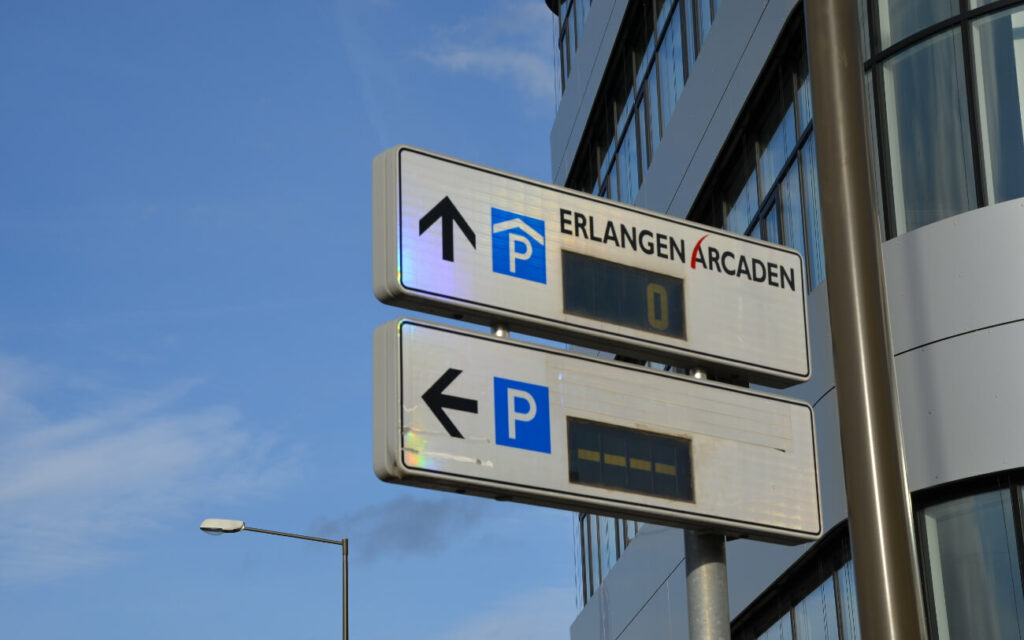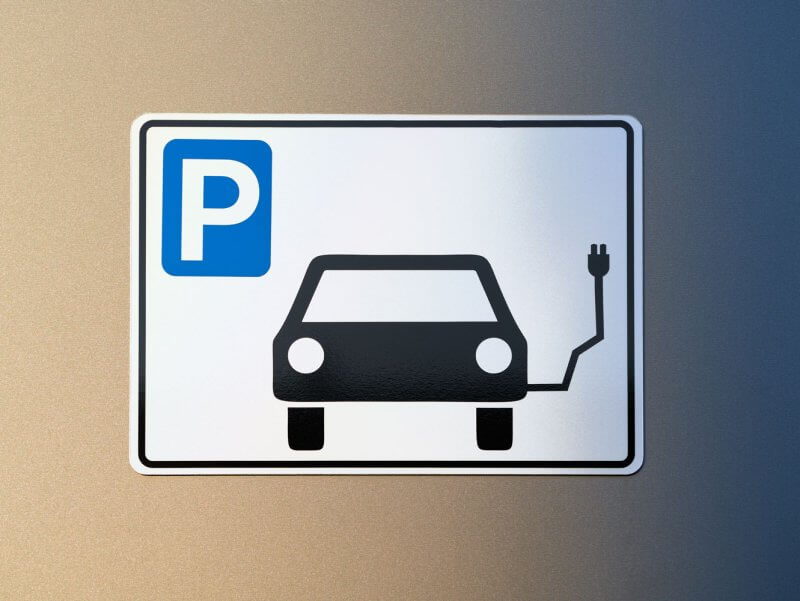Parking guidance systems in managed parking areas

Similarly, such parking guidance systems can also be used in managed parking areas of large companies, shopping centers, leisure facilities and the like. The focus here is on cost-effectiveness, flexibility and dynamism.
Find free spaces quickly and avoid traffic jams
For every facility with a large number of parking spaces, the question arises as to how the parking space can be structured as clearly and conveniently as possible for the parker. The biggest challenge is usually to find the few free parking spaces among a large number of occupied parking spaces. This often results in long searches or even traffic jams in and around the parking area. This problem can be almost completely solved with a parking guidance system.
Possibilities for implementation:
- Display the number of free parking spaces: Parking users are informed of the number of free parking spaces with the help of display panels by counting vehicles entering and leaving the parking lot. The computer uses this information to calculate the remaining number of free parking spaces and transmits the result to the display board. If there are several parking garages or floors available, the parker can go directly to where the most free parking spaces are available. This saves a long search for the one free parking space out of hundreds.
- Mark free parking spaces: Parking guidance systems go one step further by also marking their parking spaces, for example with red and green lights. The parking spaces are monitored by cameras - as soon as a vehicle occupies or vacates a parking space, the color of the light changes (red = occupied, green = free). In this way, a glance across the parking area is enough to identify the location of a free parking space.
- Guiding to free parking spaces: Parking guidance systems that guide drivers directly to a free parking space offer even more convenience. The parker only has to follow the (digital) signs to get to "their" parking space. This has the additional advantage of positively influencing the flow of traffic by avoiding traffic jams and relieving congestion on popular routes at peak times.
Each of these parking guidance systems can be implemented either directly on site or additionally / alternatively via an app. For example, in addition to free parking spaces with corresponding navigation, available pool vehicles or even live routes of company buses can be integrated on a factory site.
Reservation of parking spaces - dynamic use of available spaces
The corresponding parking app is stored on all company devices as a standard application and made available to all employees to download for their private phones. In addition to the pure display, functions such as the reservation of parking spaces/pool vehicles are also conceivable. Another advantage is that parking spaces that are reserved in principle can be made available at short notice, for example if the employee in question is on vacation or on a longer business trip. This enables flexible and dynamic use of the parking space, which not only provides convenience for the parker but also economic benefits for the operator.
Parking guidance systems provide real-time information about the current parking situation and enable dynamic traffic flow management. They therefore have numerous advantages over conventional signage - both for the parking space operator and its users.
FAQ
What are the advantages of a modern parking guidance system?
A modern parking guidance system offers numerous advantages for drivers and operators: it reduces parking search traffic through real-time navigation to free parking spaces, which reduces congestion and CO2 emissions. Intelligent control optimizes the utilization of parking spaces and increases efficiency. For drivers, this means less stress and time saved when looking for a parking space. Operators benefit from better monitoring by sensors and cameras as well as extensive analysis options to optimize their offer. In addition, modern systems enable integration into smart city concepts and offer flexible reservation options.
What types of parking guidance systems are there and which are best suited for large parking lots?
Parking guidance systems can be divided into different technological categories, each of which offers specific advantages and disadvantages for large parking lots. The most important systems are
Sensor-based systems
Magnetic field-based systems use ground sensors to detect parking space occupancy, while ultrasonic and infrared systems detect the presence of vehicles using corresponding sensors.
Camera-based systems
These systems use video technology to identify free parking spaces and are particularly effective for large areas as they can monitor several parking spaces simultaneously.
Digital systems
App-based solutions provide real-time information on parking space availability and reservation options. These can be combined with GPS technology to enable precise navigation to available parking spaces.
Recommendation for large parking lots
A combination of camera systems and app-based management is particularly suitable for large parking lots. This offers:
- Real-time monitoring of parking space occupancy
- Advance planning and reservation options
- Efficient traffic management
- Integration into existing cabinet systems
Modern license plate recognition in conjunction with app control offers the most comprehensive solution for large parking areas, as it optimizes both access control and the search for parking spaces.
How does a digital parking guidance system work in detail?
A digital parking guidance system records and processes parking space data in real time using various sensor technologies and makes this information available to drivers. The data is recorded using ground sensors, magnetic field sensors, cameras with license plate recognition or ultrasonic sensors, which determine the occupancy status of the parking spaces. This data is transmitted to a central control unit, which evaluates it and forwards it to drivers via digital display panels, smartphone apps or navigation devices. This guides drivers directly to available parking spaces, which reduces traffic searching for parking spaces and optimizes parking space utilization. The software also enables digital management of parking spaces with functions such as cashless payment, reservations and utilization analyses.
What advantages does a parking guidance system have for customer satisfaction?
A parking guidance system significantly increases customer satisfaction as it enables drivers to find a free parking space quickly and stress-free. Real-time information on available parking spaces noticeably reduces waiting times and tailbacks, resulting in a more relaxed parking experience. The automatic detection of free parking spaces also optimizes the overall utilization of parking areas and prevents frustrating search trips. Modern systems offer additional convenience through digital payment options and protect customers from disadvantages such as ticket loss or damage, which has a positive impact on the overall customer experience.
How is a parking guidance system installed and put into operation?
A parking guidance system is typically installed and implemented in several steps. First, a needs analysis and individual project planning of the parking area is carried out. The actual installation then includes the installation of the necessary hardware such as sensors (e.g. cameras, ultrasonic or magnetic field sensors), digital display panels and a central control unit for data processing. The sensors record the occupancy of the parking spaces and transmit this information to the control unit in real time. The processed data is then passed on to drivers via the display boards or a mobile app. After the technical installation, the system is integrated and connected to existing infrastructures. The entire installation and commissioning process can be completed within a few days. A service team is then available for further support and optimization of the system.
Can a parking guidance system be integrated with existing IT and building management systems?
Modern parking guidance systems can be easily integrated into existing IT and building management systems. Thanks to open interfaces (APIs) and standardized protocols, parking management solutions can be connected to various company applications, time recording tools, payroll accounting and barrier systems. Integration is usually software-based and does not require any costly hardware investments. Parking data from different sources such as sensors, barriers and parking machines can be merged and shared on a central platform. Cloud-based systems also enable rapid implementation without major structural changes. Networking creates valuable synergy effects between different systems, from which both operators and users benefit.
How data-secure and GDPR-compliant are modern parking guidance systems?
Modern parking guidance systems are designed in compliance with strict data protection guidelines and are GDPR-compliant. License plate recognition is based on the legitimate interest of the parking operator (Art. 6 para. 1 lit. f GDPR) and is subject to clear rules: The recorded license plates are automatically deleted at the end of the parking process, provided there is no parking violation. Only the data required for the parking process is recorded and no images of people are stored. Data processing is limited to the license plate number and entry and exit times, while the data is stored in Germany. In addition, parking space operators must display appropriate signage before entry to indicate that license plates are being recorded and allow a grace period during which the parking space can be left without the obligation to pay. All processing is encrypted and takes into account technical and organizational measures to protect the data.





